November 2012
Monthly Archive
Tue 27 Nov 2012
REVIEWED BY MICHAEL SHONK
COOL MILLION , NBC / Universal, October through December 1972. Created by Larry Cohen. Cast: James Farentino as Jefferson Keyes.
Jefferson Keyes was a World renown detective, trained by an unnamed secret agency of the American government, and able to charge one million dollars per job. But Jeff was quick to point out he paid for all his expenses, and guaranteed to solve the client’s problem or the client would owe him nothing. Also, Jeff always denied being a detective or PI, instead he saw himself more of a trouble-shooter. “I’m not a detective,†said Jeff in “Mask of Marcella,” “I simply look for solutions to rather large problems.â€
https://www.youtube.com/watch?v=8n2JPO5SEhg
“Mask of Marcella.” (10/16/72) Executive Producer: George Eckstein. Producer: David J. O’Connell. Written by Larry Cohen. Directed by Gene Levitt. Guest Cast: Barbara Bouchet, Patrick O’Neal, John Vernon, and Christine Belford. *** TV Movie pilot. When a rich man is murdered, everyone is surprised to learn he had recently changed his will to leave his entire fifty million dollar estate to his daughter, Marcella…who had disappeared as a child and been missing and presumed dead for thirteen years.
The child’s former teacher whose negligence lead to her disappearance has seen Marcella alive and wants Jeff to find her so he can find redemption (and get his teaching credentials back). The lawyers for the estate agree to hire Jeff to find the proper heiress. He has one week to find Marcella before the probate court turns her inheritance over to charities.
Cohen’s pilot script sets up the character of Jefferson Keyes well. Jeff travels the world alone, solving people’s problems. Jeff makes no apologies for his fee or lifestyle, but he does care more about people than money. In this case, we learn he is a regular contributor to a London Children’s hospital, and he even gives one third of his fee to a person in need.
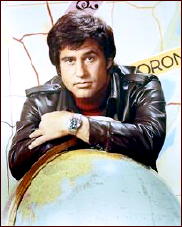
NBC picked up the pilot and added it as one of three rotating series on NBC Wednesday Mystery Movie, sharing the time period with Banacek and Madigan. The series aired between 8:30 to 10pm and was opposite of ABC Wednesday Night Movie and CBS’s lineup of the last half hour of Carol Burnett, and Medical Center.
Roy Huggins took over when Cool Million went series. Executive Producer George Eckstein stayed with his other TV Movie pilot Banacek. Producer David J. O’Connell at the time was the producer of Marcus Welby M.D. (where he won an Emmy in 1972). And Larry Cohen’s Bone (1972), the first theatrical film Larry Cohen directed (he also wrote and produced) had all ready been released. Black Caesar (1973) would soon follow.
I should note here the episodes I saw were collector copies of the edited reruns aired on CBS Late Show, the credits where Executive Producer Roy Huggins and his company the Public Arts Production title would normally appear were missing, but there is little doubt Huggins was responsible for the series episodes.
Huggins made some changes to Cohen’s original idea. Jefferson Keyes no longer wandered the world alone, now he had a staff to support as well as gratuitous over the top expenses such as a special car that is flown to him anywhere in the world.
Receptionist Elena (Adele Mara aka Mrs. Roy Huggins) lived in a house in Lincoln, Nebraska where a hidden panel let you into a room full of the latest in computers. Mother of at least one small never seen child (a “Big Wheel†blocking the secret entrance in one episode), she spoke at least two languages — English and Persian. Jeff didn’t want to miss a call, so he established a trunk line in Lincoln where the lines were always clear. She would ask security questions of possible clients to confirm their id before notifying Jeff.
Tony Baylor (Ed Bernard or Felton Perry) was the pilot for Jeff’s personal plane. In the pilot, Jeff flew commercial airlines or chartered a private plane he flew himself. Now, Jeff adds to the expenses and payroll with a smart-ass pilot.
“Hunt for a Lonely Girl.” (10/25/72) Written, directed, and produced by Gene Levitt. Associate Executive Producer: Jo Swerling Jr. Guest Cast: Kim Darby and Ray Milland. *** Rich spoiled Canadian businessman with anger management problems is on trial for murder. His lawyer hires Jeff to find proof of the man’s alibi.
Worst episode. Levitt had no clue about who Cohen’s Jefferson Keyes was. In this episode Jeff did the work of a PI legman while repeatedly denying he was a PI and constantly whining about money.
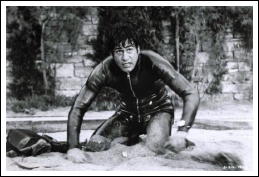
“Assault on Gavaloni.” (11/22/72) Teleplay by Juanita Bartlett. Story by John Thomas James (Roy Huggins). Directed by John Badham. Produced by Jo Swerling, Jr. Guest Cast: Nehemiah Persoff, Pamela Franklin, Wilfred Hyde-White, Joanne Barnes, Ilka Chase. *** Sir Bryan Howard had lent a painting to a man so he could keep his ex-wife from getting it. But now the man won’t return it. Sir Howard hires old friend Jefferson Keyes to get it back.
Good episode capturing the style of the NBC Mystery Movies (over the top adventure with romance and high living backed by the signature soundtrack of the Universal music library). This was the only episode besides the pilot to handle the money gimmick well. Jeff puts his concern for a woman before the money and the case. He is reluctant to charge his old friend his fee until Sir Howard admits he has made a profit despite Jeff’s million-dollar fee.
“The Abduction of Baynard Barnes.” (12/6/72) Teleplay by Richard Morris. Story by John Thomas James. Directed by Barry Shear. Produced by Jo Swerling Jr. Guest Cast: Barry Sullivan, Danielle DeMetz, Sharon Gless, and Nico Minardos. *** Jeff is hired to rescue a kidnapped millionaire who had left orders never to pay ransom.
Plot was typical 70s with a far-fetched rescue and long chase. The episode made good use of Jeff’s spy training and attempted to explain the need of Jeff’s fee with expensive gadgets and high priced help.
“The Million Dollar Misunderstanding.” (12/20/72) Teleplay by Juanita Bartlett. Story by John Thomas James. Directed by Daryl Duke. Produced by Jo Swerling Jr. Guest Cast: Elaine Giftos, Ina Balin, Joseph Ruskin, and John S. Ragin. *** After three months of work where he convinced a daughter of a President of a small Middle Eastern country to return home, Jeff gets paid, only to have the check bounce. Jeff wants his money and orders his pilot Tony (Felton Perry) to help him steal a two million dollar diamond from his former client and ransom it for his million.
Jeff is at his most unlikable in this episode. He works for three months to convince his client’s daughter to return home, yet despite Elena and the computers security check, Jeff did not know his client was a deadbeat dictator hated by his people. So does Jeff worry about the young daughter? No, all Jeff wants is his money, and he is willing to risk others lives to get it. This was the last episode of the series.
In Broadcasting (1/15/73) the ratings for all TV Movies from the beginning of the 1972-73 season until December 3, 1972 were listed. The NBC Wednesday Mystery Movie was ranked 23rd out of 66 shows with a 20.5 average. Each episode of NBC Wednesday Mystery Movie was also listed.
Most popular of the three was Banacek with five episodes (during the period covered) rated (in order) 21.2 – 22.3 – 20.9 – 19.4 – 23.5. Madigan had three episodes: 21.4 – 20.3 – 18.9.
“Mask of Marcella” was shown on NBC Monday Movie (9-11pm) and received a rating of 20.4 to finish 25th in the ratings for the week, but finished last in its time period. “Hunt for a Lonely Girl” received a rating of 19.0 for 28th in the ratings. “Assault on Gavaloni” dropped to 17.5. I was unable to find the ratings for the final two episodes.
During the 70s, PIs usually featured a gimmick to set them apart. “Cool Million” gimmick was Jeff’s fee. Too often in the series episodes Jefferson Keyes was a mercenary whining about expenses, risking others lives so he can collect his fee, and wasting too much money on unnecessary over the top expenses.
For those curious about NBC Mystery Movies I recommend you check out J. Kingston Pierce’s work in progress at his “Rap Sheet” blog. I beat him to Cool Million, but I look forward to read what he can add. While we wait, read his posts about Madigan, Banacek and McMillan and Wife.
Mon 26 Nov 2012
Posted by Steve under
Reviews[7] Comments
REVIEWED BY DAN STUMPF:
DAVID GOODIS – Black Friday. Lion #224, paperback original, 1954. Black Lizard, paperback, 1987.
“It’s Black Friday and for certain people it’s a day that never ends.â€
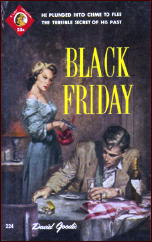
Black Friday (Lion, 1954) shows us David Goodis at his lean and hungry best with a taut, compelling crime story that seems to be constantly hurtling toward some predestined end, yet shaped by its own very unique and lively cast of characters.
As it opens, Al Hart is on the run, fleeing the police after the mercy killing of his terminally ill brother, making his broken down and desperate way through one of those Philadelphia winters that Goodis does so bitterly well. Through a series of coincidences he finds himself witness to a murder and tentatively taken in by a gang of professional thieves who accept him (more or less) as one of them — and plan to use him on their next job.
These thieves turn out to be quite an interesting crowd. In fact, Goodis peoples Black Friday with the archetypes familiar to his fans: The brassy, overripe slut, the ethereal gamin, the oddly sensitive master criminal, the not-so-dumb brute, and the alienated, ostracized hero—characters who show up in one incarnation or another in various Goodis books from Dark Passage to Somebody’s Done For, and who seem to resurrect themselves anew on the page each time.
For this particular ride, they’re set down amid a tense caper that seems all the more suspenseful for being jinxed from the outset. There’s something Homeric in Goodis’ trick of thrusting bums and winos into heroic situations and watching them rise to mythic status. Here, his second-rate hooligans and gallant loser-as-paladin turn a well-crafted caper yarn into something truly memorable.
Editorial Comment: Dan sent me this review just before Thanksgiving, when it would have been a little more timely, perhaps. I wish I’d been able to get it posted here before now, but this was the best I could do, only a few days late.
Sat 17 Nov 2012
I’m going to be busy for the next week or so, hopefully not any longer than that. Company’s coming, a changeover to a new computer, Turkey Day, and another outpatient surgery scheduled for Friday.
I’ll be back as soon as I can. Have a great holiday, everyone!
Thu 15 Nov 2012
Posted by Steve under
ReviewsNo Comments
LUKE SHORT – Last Hunt. Bantam A2437, paperback original. First printing, August 1962. Reprinted several times, including: Dell, paperback, 1990.
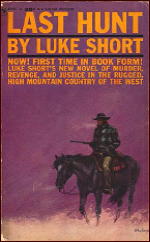
You take a glance at the cover, it looks like a western: pictured is a man with a rifle on a horse, bundled up against the cold. You read the cover, it sounds like a western: “Luke Short’s new novel of murder, revenge in the rugged, high country of the west.†You start reading the first chapter, you could easily be confused into thinking it is a western — it is a Luke Short novel, after all.
That’s assuming, of course, you’re as easily confused as me. It wasn’t until page 7, where you will find a reference to someone unzipping his Eisenhower-type jacket that it dawned on me. It’s not a western.
Not one of the Old West, that is. What this is a modern day crime story, a detective story, one that takes place in the west, and yes, it’s in Hubin’s Crime Fiction IV. Murdered while hunting elk is a judge, a man who has just recently made a bitter enemy in a messy divorce case that just concluded in his courtroom.
Keeping in mind that I never really enjoyed the TV show Columbo all that much — you know the routine: the killer is known from the very beginning, and for the remainder of the program, the pleasure comes from watching the Lieutenant putting the pieces together and figuring out and trapping the culprit — I found it annoying that the same approach is what Short uses here. Let me quickly qualify that and say “mildly annoying.â€
For the most part, this is a man’s sort of book, filled with men who enjoy hunting, enjoy the out-of-doors and the companionship of other men, and with women who put up with, if not love, the kind of men who enjoy hunting — and so on. This is the time and place when people left their cars parked with the keys left in them, and there’s a definite nostalgia for times that no longer exist that comes into play as well.
In a small way this short novel (only 122 pages) reminded me of one the the old Gold Medal paperback originals that started coming out in the early 1950s, but upon second thought, I finally decided it lacks the pulpish edge (bordering on sleaziness) that those old GM paperbacks had.
In terms of the quality of the writing itself, Luke Short’s second of two entries (*) into straight crime fiction has a pulpish tinge, all right, but you also get the feeling that the story first appeared in — and was filtered through — a slick magazine like Collier’s or The Saturday Evening Post, which of course, it probably did.
The people that are encountered here are friendlier, and with perhaps one exception, they lack the quiet desperation in their lives the inhabitants of the Gold Medal novels usually had, the kind that pushes them into situations in which they soon discover that they’ve lost control of the events that follow.
What the big difference may be, and this may sound overly sentimental, is that when Last Hunt ends, you’ve become friends with the people in it, and you’re left wanting to know what happens to each of them in the rest of his or her life, and if it turns out as well for them as you want it to do.
(*) The other title is Barren Land Murders, which as a matter of fact was a Gold Medal PBO, from 1951.
— Reprinted from
Durn Tootin’ #5,
July 2004 (slightly revised).
Thu 15 Nov 2012
Hi Steve,
W. B. M. Ferguson’s dates are given everywhere, including Crime Fiction IV, as 1881-1967. The birth is correct according to the Irish births registration, but I have now found in the English National Probate Calendar the death of a William Blair Morton Ferguson on 12 January 1958 in Londonderry.
I have told Allen Hubin as it seems unlikely there are two people of that name, though one never knows.
But, as I have said, as the 1967 death is given everywhere, I wonder if you could mention this to see if anyone can provide more information. It would also help to spread the word of that incorrect date – if it is incorrect.
Many thanks
John
BIBLIOGRAPHY [Taken from Crime Fiction IV, by Allen J. Hubin] —
FERGUSON, W(illiam) B(lair) M(orton) (1881-1967); see pseudonym William Morton; Born in Belfast.
* *The Big Take (Long, 1952, hc) [U.S.]
* *-Black Bread (Long, 1933, hc)
* *The Black Company (Jenkins, 1925, hc) [New York] Chelsea, 1924.
* *Boss of the Skeletons (Long, 1945, hc) [New York City, NY; 1920 ca.]
* _The Clew in the Glass (Chelsea, 1926, hc) See: The Clue in the Glass (Jenkins 1927).
* *The Clue in the Glass (Jenkins, 1927, hc) [U.S.] U.S. title: The Clew in the Glass. Chelsea, 1926.
* *Crackerjack (Long, 1936, hc) Film: Gainsborough, 1938; released in the U.S. as Man with 100 Faces (scw: A. R. Rawlinson, Michael Pertwee, Basil Mason; dir: Albert de Courville).
* *Dog Fox (Long, 1938, hc)
* *Escape to Eternity (Long, 1944, hc) [Dan Cluer; New York City, NY]
* *The Island of Surprises (Long, 1935, hc)
* *London Lamb (Long, 1939, hc)
* _The Murder of Christine Wilmerding (Liveright, 1932, hc) See: Little Lost Lady (Hurst 1931), as by William Morton.
* *Other Folks’ Money (London: Nelson, 1928, hc) Chelsea, 1926.
* *Phonies (Long, 1951, hc) [New York City, NY; U.S. West]
* _The Pilditch Puzzle (Liveright, 1932, hc) See: The Murderer (Hurst 1932), as by William Morton.
* *Prelude to Horror (Long, 1943, hc)
* *The Riddle of the Rose (Jenkins, 1929, hc) [New York] McBride, 1929.
* *Sally (Long, 1940, hc)
* *The Shayne Case (Long, 1947, hc) [Dan Cluer; New York City, NY]
* *Somewhere Off Borneo (Long, 1936, hc)
* *The Vanishing Men (Long, 1932, hc)
* *Wyoming Tragedy (Long, 1935, hc) [Wyoming]
MORTON, WILLIAM; pseudonym of W. B. M. Ferguson, (1881-1967)
* *The Case of Casper Gault (Hurst, 1932, hc) [Police Commissioner Kirker Cameron; *Insp. Daniel “Biff†Corrigan; New York]
* *The Edged Tool (Chelsea, 1927, hc)
* *Little Lost Lady (Hurst, 1931, hc) [New York] U.S. title: The Murder of Christine Wilmerding, as by W. B. M. Ferguson. Liveright, 1932.
* *Masquerade (London: Nelson, 1928, hc) [*Insp. Daniel “Biff†Corrigan; New York] Chelsea, 1927.
* *The Murderer (Hurst, 1932, hc) [*Insp. Daniel “Biff†Corrigan; Police Commissioner Kirker Cameron; New York City, NY] U.S. title: The Pilditch Puzzle, as by W. B. M. Ferguson. Liveright, 1932.
* *The Mystery of the Human Bookcase (Hurst, 1931, hc) [*Insp. Daniel “Biff†Corrigan; Police Commissioner Kirker Cameron; New York City, NY] Mason (U.S.), 1931.
Tue 13 Nov 2012
THE BACKWARD REVIEWER
William F. Deeck
WILSON TUCKER – The Chinese Doll. Rinehart, hardcover, 1946. Detective Book Club, hardcover, 3-in-1 edition, May 1947. Dell #343, mapback edition, 1949.
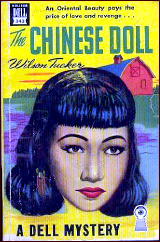
While you might think that a private detective in Boone, Illinois, would be underemployed, you would be right. In this documentary novel — in the form of letters from Charles Horne to Louise, the woman he is in love with — Horne is in his office trying to keep warm and working on his book, Lost Atlantis, of which seven chapters have been completed.
Into the office comes Harry W. Evans, who gives Horne $500 to bail him out of jail since he claims he will inevitably be arrested for spitting on the sidewalk, or jaywalking, or shoplifting, or whatever.
Naturally, Home is somewhat nonplussed, for the authorities in Boone are not noted for monkey business. To coin a phrase — or is it a clause? — little does he know. Evans leaves Home’s office, and as Horne is watching, a Studebaker sedan with supercharger strikes Evans, killing him, and then speeds off. Later Horne is invited into another Studebaker with supercharger, this time a coupe, driven by a beautiful Chinese girl, and ends up at an illegal gambling club.
All of this and another “accidental” death tie in with Evans. Horne doggedly and intelligently — though not brilliantly — investigates, getting some idea of who Evans was through Evans’s membership in an amateur publishing association and discovering another beautiful Chinese girl.
Even after he’d metaphorically rubbed my nose in it, Tucker fooled me on the villain, for which I give him great credit. The novel is well-written, amusing, and believable, up to the point of revealing the villain.
While I probably won’t make myself clear here, I accept that the villain was who Tucker says it was — the facts, once Horne pointed them out, prove it — but I don’t accept that the villain was who Tucker says it was. You’ll have to read the book to see what I mean, and you ought to read it anyhow, for it’s an excellent private-eye novel.
— From The MYSTERY FANcier, Vol. 13, No. 4, Fall 1992.
NOTE: Wilson “Bob” Tucker, was much more well known as a Science Fiction fan and author than he was a mystery writer. His entry on Wikipedia can be found here.
The Charles Horne series:
The Chinese Doll.Rinehart, 1946.
To Keep or Kill. Rinehart, 1947.
The Dove. Rinehart, 1948.
The Stalking Man. Rinehart, 1949.
Red Herring. Rinehart, 1951.
Sun 11 Nov 2012
REVIEWED BY MICHAEL SHONK:
HARRY O — Season 2, Part 2.
HARRY O. ABC / Warner Brothers. Season 2, Part 2. Midseason 1976, Thursday at 10-11pm. Cast: David Janssen as Harry Orwell, Anthony Zerbe as Lieutenant. K.C. Trench, Paul Tulley as Sergeant Roberts. Created by Howard Rodman. Executive Producer: Jerry Thorpe.
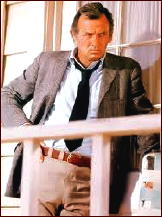
For the rest of the credits and Part One of this review please click here.
In 1975 Fred Silverman left CBS and became the head of the programming department of ABC. His midseason 75-76 changes to the ABC schedule had been a surprising success, and for the first time in the history of television ABC had a real chance to become the number one network in the ratings. ABC’s success would not be good news for Harry O.
Meanwhile, Harry O began 1976 with one of my favorite episodes:
“Mister Five and Dime.” (1/8/76): A female classmate (Glynnis O’Connor) of Lester Hodges (Les Lannom) is arrested for passing counterfeit money and she asks him for help. Lester, of course, turns to Harry.
Robert C. Dennis script featured a far-fetched plot and was laugh out loud funny. The script had enough twists to please Chubby Checker. What made the story so much fun was how Harry continued to get Trench into trouble with one federal agency after another. Director Richard Lang added some nice comedic touches to the jail scenes.
“Book of Changes.” (1/15/76): Jamie (Joanne Nail), a twenty year-old employee of a gambling club, witnesses the murder of her boss, Kate (Barbara Cason) during a robbery. Jamie runs, but does as Kate had earlier instructed her and delivers a tape addressed to: Harry Orwell, 1101 Coast Blvd, Santa Monica. On the tape the now deceased Kate hires Harry (Trench had told her Harry was the best PI in the business) to find her book of names she had for protection and for Harry to destroy it.
An average Harry O story with little mystery, less logic, and made watchable by Janssen and Zerbe. Harry’s love life takes a twist as Jamie tries to get Harry into bed and Harry resists due to the age difference. Director Russ Mayberry adds a nice visual touch to the cliché TV fight scene at the end with an overhead shot that gave us a great look at Harry’s home.
Trivia: Before he destroyed the book, Harry teased Trench by (pretending?) to read the name of K. C. Trench in the book. This is the only time K.C. was used, until then we wondered if Trench’s mother had named him Lieutenant.
“Past Imperfect.” (1/22/76): After spending eight years in prison, a conman turned killer (Tim McIntine) is out and looking for his old suitcase he had left with his now ex-partner (Susan Strasberg). Not knowing the old suitcase was important, she had left it behind in San Diego when she went straight and moved to L.A. Two mob-hired killers (Granville Van Dusen and Edward Power) and a mysterious man (David Opatoshu) also want the suitcase.
One of the worse episodes of the series as it was one stupid illogical scene after another. In between pointless scenes of violence, Harry beds another client, this time rudely rejecting Sue (Farrah Fawcett-Majors). Trench nearly gets the client killed in the most inept stakeout in Harry O history. And the solution to the mystery of what is in the suitcase is obvious to any student of mysteries.
“Hostage.” (2/19/76): Richard (John Rubinstein) robs a liquor store where drug dealers were scheduled to purchase a large amount of heroin. But the buyers were late, and instead of the cash there is only drugs in the safe. To make matters worse, cops spot the hold-up and one of them is shot, creating a hostage situation that is televised live. Harry has to find Richard’s junkie girlfriend (Ayn Ruymen) before the young man starts killing the hostages: Trench, a rich politician’s beautiful daughter (Collen Camp), and the drug-selling storeowner (George Loros).
A serious social problem (drugs) turned into a simplistic TV melodrama made entertaining only because of the cast. Paul Tulley as Roberts has more to do than usual and does it well.
“Forbidden City.” (2/26/76): A friend of Harry’s, PI George Dillard (Jerry Hardin) phones Harry for help (interrupting Harry and Sue’s “quality†time). Dillard asks Harry to meet him in Chinatown but is killed before he gets there. Harry learns how difficult it is for an “outsider†to find answers in Chinatown.
Entertaining mystery but with few surprises.
“Victim.” (3/4/76): A woman (Cynthia Avila) hires Harry to prove two of her co-workers (Michael Lerner and Cal Bellini) raped her.
Predictable as it sounds, the only scenes worth watching feature Harry, Trench and Roberts, who does a great Trench impression.
“Ruby.” (3/11/76): Prostitute and one of Harry’s contacts, Ruby (Margaret Avery) asks Harry for help. She has changed careers to Nurse after she took in her nephew (Stanley Bennett Clay) when his father died. Now the nephew is in jail for stealing a car and killing a cop in a car accident. In a wasted Charles Dickens inspired twist, a mobster (Joe Ruskin) has a gang of poor young men stealing cars for him.
Typical TV drama with some terrible dialog and obvious twists, but the episode was a good example of how PI (hunch player) Harry and cop (just the facts) Trench worked together, with Trench handling the “by the book†procedural side and Harry doing the PI “without rules†side.
https://www.youtube.com/watch?v=LmDZ0KqsZRg
“The Mysterious Case of Lester and Dr. Fong.” (3/18/76): Old rich man (Dean Jagger) gathers his family together to announce he has hired Harry to find out which one of them has threaten to kill him. He then dies…of natural causes. But one family member, Lester Hodges believes the old man was murdered. Lester convinces famous criminalist Dr. Creighton Fong (Keye Luke) to look into the death, and the good Dr. Fong finds evidence of poison.
Janssen had a reduced but important part in this backdoor pilot for a possible series featuring Lester and Dr. Fong. Trench was thrilled to work with the brilliant and respected Dr. Fong even if it meant having to deal with the aggravating Lester. Every time Fong found evidence that lead Lester to convince Trench to arrest a suspect, that suspect would die.
Lester and Fong were two supporting characters in need of a lead character strong enough to carry a series. By the end of this you will realize how much of the success of the characters Trench and Lester were due to Harry Orwell and David Janssen.
“Death Certificate.” (4/29/76): Young widow (Denise Galik) and her demanding mother (Ruth Roman) had filed a malpractice suit over the death of her husband. The widow had been beaten and ordered to drop the suit. They go to Harry for help. Harry finds little to help the malpractice suit, but all the threats and violence makes him (and Trench) wonder if the husband had been murdered.
As usual, we are more interested in what happens to Harry and those around him than the case itself. Harry’s car again fails him, this time with tragic consequences.
While David Janssen and the chemistry of the cast and characters are the primary reasons for us remembering Harry O as one of television’s best mystery dramas, the series had other virtues as well.
In Television Chronicles #10 (thanks again to Randy Cox for the copy), Ed Robertson quoted executive producer (who we today would call the series “showrunnerâ€) Jerry Thorpe about the different visual style of Harry O. “…I began to stage exclusively in forced perspective – that is, ‘up and down stage,’ as opposed to ‘stage left and stage right.’â€
This reduced the need for wide angles and master shots. It was a style Thorpe learned from Sidney Furie’s The Ipcress File (1965). Among the series directors, Richard Lang was the best at using the style and directed eighteen of the series forty-four episodes.
The writers, starting with Howard Rodman and followed by Robert Dozier, Michael Sloan and the rest understood the importance of David Janssen. They focused on how to exploit the talents of Janssen, and (in the Santa Monica episodes) the relationship between Harry and Trench by using a delightful mix of humor and situations hidden inside, at first Rodman’s darker nourish tales, then the ABC approved average TV melodramas. As a result, the series gave us two of TV’s most entertaining and memorable characters, Harry Orwell and K. C. Trench.
To the surprise of many, ABC cancelled Harry O at the end of the season.
Jerry Thorpe explained in Television Chronicles #10, “(Silverman) was looking for shows that he thought had the potential to be runaway hits. That was his philosophy. He didn’t want to settle for the ‘average.’ He wanted to take chances with shows that could really elevate the network’s standing-which was exactly what ABC needed to do at the time.â€
The article mentioned the series’ ratings had dropped by one point from the first season but was “still winning its time slot on a consistent basis.†It also noted Variety (April 1976) reaction that while Harry O was the best series of those cancelled, ABC felt Harry O’s ratings would not get any better.
It is a shame that because of ABC sudden rating success there was no longer a place for Harry O, and we never again got to watch Harry drink the last of Trench’s coffee or hear Trench scream “Roberts!†as he followed Harry out of his office to question the next suspect.
Now if only Warner Brothers would release the second season on DVD.
Links to the rest of my series of Harry O reviews:
GERTRUDE
SAN DIEGO
SEASON ONE, PART TWO
Sat 10 Nov 2012
ELIZABETH BACKHOUSE – Death Came Uninvited. Robert Hale, UK, hardcover, 1957.
You can find unusual items on eBay, and for me, this is one I recently ended up winning. My copy is a rather shabby ex-library edition which cost me perhaps a pound, plus double that for shipping from England.
Elizabeth Backhouse, the flap of the jacket says, is a young Australian writer, and this is her first novel. This sends me to Al Hubin’s [Crime Fiction IV] almost immediately, mostly out of curiosity to see if she ever wrote another.
And indeed she did. Here are all her books of crime fiction, at least, in chronological order:
Death Came Uninvited. Hale, 1957. [Inspector Christopher Marsden]
The Mists Came Down. Hale, 1959.
The Web of Shadows. Hale, 1960. [Inspector Prentis]
The Night Has Eyes. Hale, 1961. [Inspector Marsden]
Death of a Clown. Hale, 1962. [Inspector Prentis]
Death Climbs a Hill. Hale, 1963. [Inspector Prentis]
Inspector Marsden is her English policeman, while Inspector Prentis, about whom I know nothing else, is Australian. It may be that Ms. Backhouse’s story-telling techniques took on extra dimensions as she continued to write, but in at least her first book, we see and follow Marsden when he’s on the job, and nowhere else, so as it turns out, I know very little about him as well.
No wife, girl friend, no home life, nothing at all except — it’s not much, but it will have to do — he does have a dog, one who follows his master around with him as he interviews suspects and follows clues. The dog’s name is Spodge, which sounds terribly authentically British to me.
In pure pulp fashion, you might say — not the hard-boiled Hammett stuff — but the gentleman-adventurer-slash-drawing-room sort of tale, the murderer kills his first victim using a sealed envelope filled with ammonia, leaving a calling card for the crime, signed “The Uninvited.”
And so the pursuit is on. There are lots of suspects in an increasingly complicated plot, but what Marsden and his men failed to do, it seems to me, is to ever ask the question, “Why such a complicated means to do murder?†and “Why did the murderer feel that he was uninvited?”
Or, where is Ellery Queen when we need him? As for me, I let Marsden and his men do all of the legwork, I concentrated on the second question (the first one has no answer), and I worked out the entire solution before any of them.
I don’t brag. I only tell it how it is. The case is still entertaining, save for a small amount of muddled telling toward the end, and I could see why. The author was trying to keep the surprise ending up her sleeve for as long as she could, and there wasn’t nearly room enough for her to maneuver.
Fri 9 Nov 2012
REVIEWED BY DAN STUMPF:
GIL DODGE – Flint. Signet #1414, paperback original, 1957. Included in 3 Steps to Hell as by Arnold Hano, Stark House, softcover, October 2012, along with So I’m a Heel and The Big Out.
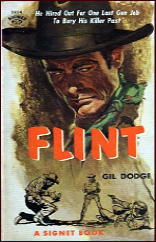
Flint offers some fine Western characters and a terse, hard-boiled opening, but ultimately it’s more interesting for the story behind it than the story within.
Arnold Hano, the editor-in-chief at Lion Books back in the 1950s ought to be legendary for the quality of the work he sustained. While not every Lion Book was a classic of its time, Hano gave work to writers like Jim Thompson, Robert Bloch, David Goodis and Richard Matheson when they needed it most. And he didn’t just give them work, he gave them free rein to indulge their pulpy passions on the printed page.
Books like The Kidnaper, The Killer Inside Me, The Burglar and Someone Is Bleeding teem with genuine artistry inside their gaudy covers that would be admirable anywhere, and simply amazing inside a cheap paperback.
So when I learned that Hano himself wrote a western based on Jim Thompson’s Savage Night (with Thompson’s blessing) I came to it with high expectations — maybe too high. It starts well, with Flint, a notorious Hired Gun, previously lung-shot and in hiding, making his painful way across barren countryside to keep a rendezvous with a mysterious cattle baron named Good who needs a job done right—very close to the same situation the tubercular Charlie Biggers walks into in Savage Night.
And in short order, Flint finds himself working a run-down ranch with his intended target, a rancher named Thomason (get it?) romancing a buxom wife and playing cat-and-mouse with Good’s henchman and a slovenly sheriff.
And then [SPOILER!] everything just kinda stops as Flint gets sucked into an elaborate, nay byzantine, game with the man who hired him, trying to figure out his place in the scheme of things and the roles and motives of the various other players. Every move Flint makes, Good has seen coming, everything he tries gets him nowhere, or leads him to where Good has figured he’d go… and nothing really happens as several chapters go by with Good’s schemes getting more complex and Flint’s efforts more futile.
Okay now, maybe this is a personal thing with me, or maybe it’s the vision and talent of the writers in question. I’ll entertain both possibilities, but in Savage Night, Jim Thompson conveys the notion of a cruel and mocking universe through which his doomed characters must wander.
And this to me was more compelling — more convincing, even — than Arno/Dodge’s picture of a nasty old man cooking up murderous plots just for the fun of seeing folks squirm. I guess the difference is that Thompson’s characters do battle with nightmares while Arno/Dodge’s simply grasp for the banal — and find it all too readily within their reach.
Thu 8 Nov 2012
THE BACKWARD REVIEWER
William F. Deeck
ALICE MacGOWAN & PERRY NEWBERRY – The Million Dollar Suitcase. Stokes, hardcover, 1922; International Fiction Library, hardcover reprint, n.d.
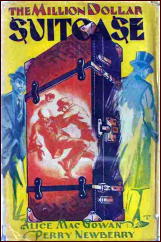
Impossible-crime fanciers get a bonus and a debit here. The bonus: There are two locked-room situations. The debit: They aren’t very good.
The first occurs when a San Francisco bank teller absconds with nearly a million dollars. Close on the teller’s heels is the bank’s private detective, Jerry Boyne. He arrives at the teller’s hotel room to find the windows latched with burglar-proof locks and the door closed with the usual spring lock.
In front of the door is a woman repairing a rug, and she had been there since the teller had entered his room. The teller had not left by the door, but neither he nor the money was in the room.
Worth Gilbert, whose father has stock in the bank, offers the bank’s board $800,000 for the contents of the suitcase. It seems he needs a challenge. While Gilbert can raise most of the money, he has to ask his father to provide the rest. After a fight with his father, he doesn’t get the money. Shortly thereafter his father is found shot to death in the second locked room.
Fortunately for Boyne, who would not have been chosen by his predecessor to head the detective agency and one can see why from the many mistakes he makes in this investigation, he has the aid, on the rare occasions he’s sensible enough to use it, of a young woman whose psychologist father trained her from childhood to be a lightning observer and reasoner. She figures out the first locked room; Boyne, after having the solution shoved under his nose, solves the second.
This novel apparently appeared first in the Saturday Evening Post as “Two and Two.” As far as I can recall, the Post printed no bad stories, but it did publish some mediocre material, in which category this falls, despite an occasional good observation such as “A financier’s idea of indecency is something about money which hasn’t formerly been done.”
Since this is the first in a series of books featuring Jerry Boyne, I’ll be looking for the other novels by MacGowan and Newberry but only to establish who solves Boyne’s other cases.
— From
The MYSTERY FANcier, Vol. 13, No. 4, Fall 1992.
BIBLIOGRAPHY: Alice MacGowan & Perry Newberry —
[All with Jerry Boyne.]
The Million Dollar Suitcase. Stokes, 1922.
The Mystery Woman. Stokes, 1924.
Shaken Down. Stokes, 1925.
The Seventh Passenger. Stokes, 1926.
Who Is This Man?. Stokes, 1927.
Next Page »





